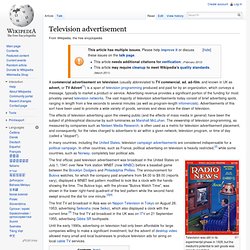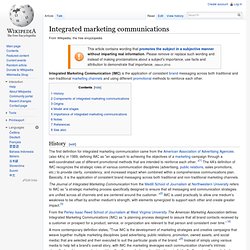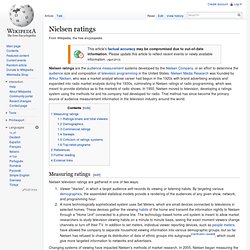

Number of U.S. TV Households Climbs by One Million for 2010-11 TV Season. Television advertisement. A commercial advertisement on television (usually abbreviated to TV commercial, ad, ad-film, and known in UK as advert, or TV Advert[1]) is a span of television programming produced and paid for by an organization, which conveys a message, typically to market a product or service.

Advertising revenue provides a significant portion of the funding for most privately owned television networks. Business & Small Business. How to Deposit Money to PayPal. Our story. Everyone’s got a backstory.

Ours continues to influence how we approach communications today. Roots in Silicon Valley. Research Study Shows TV Viewers Really Do Watch Commercials. It’s always been conventional wisdom that people watching TV don’t watch commercials.

They flip channels, get something to eat or otherwise ignore the ads. In fact, it turns out the conventional wisdom is all wrong: TV advertising and program promotions reach 85% of adults daily, and viewers typically see 26 advertising or promotional breaks -- accounting for 73 minutes -- each day. The Video Consumer Mapping (VCM) study sponsored by the Council for Research Excellence (CRE) also found that the frequency of channel-changing and moving rooms is similar before, during and after commercial breaks.
Only 14% of viewers change channels during the break, compared to 11% just before commercials and 13% just after. Likewise, room changing patterns were similar: 20% of viewers change rooms during commercials, compared to 19% before and 21% after. Integrated marketing communications. Integrated Marketing Communication (IMC) is the application of consistent brand messaging across both traditional and non-traditional marketing channels and using different promotional methods to reinforce each other.

History[edit] The first definition for integrated marketing communication came from the American Association of Advertising Agencies (also 4A's) in 1989, defining IMC as "an approach to achieving the objectives of a marketing campaign through a well-coordinated use of different promotional methods that are intended to reinforce each other. "[1] The 4A's definition of IMC recognizes the strategic roles of various communication disciplines (advertising, public relations, sales promotions, etc.) to provide clarity, consistency, and increased impact when combined within a comprehensive communications plan. Basically, it is the application of consistent brand messaging across both traditional and non-traditional marketing channels. Organizational culture Four P's Promotion.
Tech PR Awards. Top 10 Successful Marketing Stunts. Ever wonder just how far some companies will go to get noticed?

Nielsen To Begin Measuring How Many People Aren't Watching Commercials. CPM vs CPC: Which Should You Use For Facebook Ads? When getting started with online advertising, one of the first questions people will ask is, “Should I bid on a CPM or CPC basis?” Dedicated to the Growth of the Interactive Advertising Marketplace. Public Relations Agency Rankings by O'Dwyer's Public Relations News. Profiles of Top Independent PR Firms, O'Dwyer's Magazine - May 2013 O'Dwyer's magazine, now in its 28th year, is the #1 publication for PR and marketing communications pros.

The magazine has been in full text on LexisNexis since 1989--the only PR magazine on LN. Each month, a different area of PR is examined. Issues include practice-area specific feature stories as well as profiles of PR firms with strengths in the focus area of the month. The agency profiles constitute the ideal starting point for companies beginning their search for PR counsel. The magazine focuses on the firms and individuals making news in PR as well as offering articles on industry trends. Nielsen ratings. Nielsen ratings are the audience measurement systems developed by the Nielsen Company, in an effort to determine the audience size and composition of television programming in the United States.

Nielsen Media Research was founded by Arthur Nielsen, who was a market analyst whose career had begun in the 1920s with brand advertising analysis and expanded into radio market analysis during the 1930s, culminating in Nielsen ratings of radio programming, which was meant to provide statistics as to the markets of radio shows. In 1950, Nielsen moved to television, developing a ratings system using the methods he and his company had developed for radio.
18-49 Year Olds Watching Less TV. For the second year in a row, television viewership of 18-49 year olds (on traditional sets) dropped over the course of the TV season, despite the recent high ratings for show finales including American Idol and Oprah. According to Nielsen, the overall TV audience grew 1.5 percent over the past year to about 61.3 million people, but numbers for the younger demographic are down. At any given time of day, about 25.1 million 18-49 year olds were watching television—live or recorded, broadcast or cable—this TV season through May 8. Services > Interactive Design. How Online Advertising Turned Media Into a Race to the Lowest Common Denominator. Facebook Now 'Critical Player' in Online News Referrals. Facebook is driving an increasing amount of traffic to news Web sites, as is Google News, but micro-blogging site Twitter has yet to make a huge impact when it comes to helping sites boost traffic, according to a Monday study.

The Pew Research Center, which conducted its investigation with the help of data from the Nielsen Company, found that Facebook has become "a critical player in the news. "